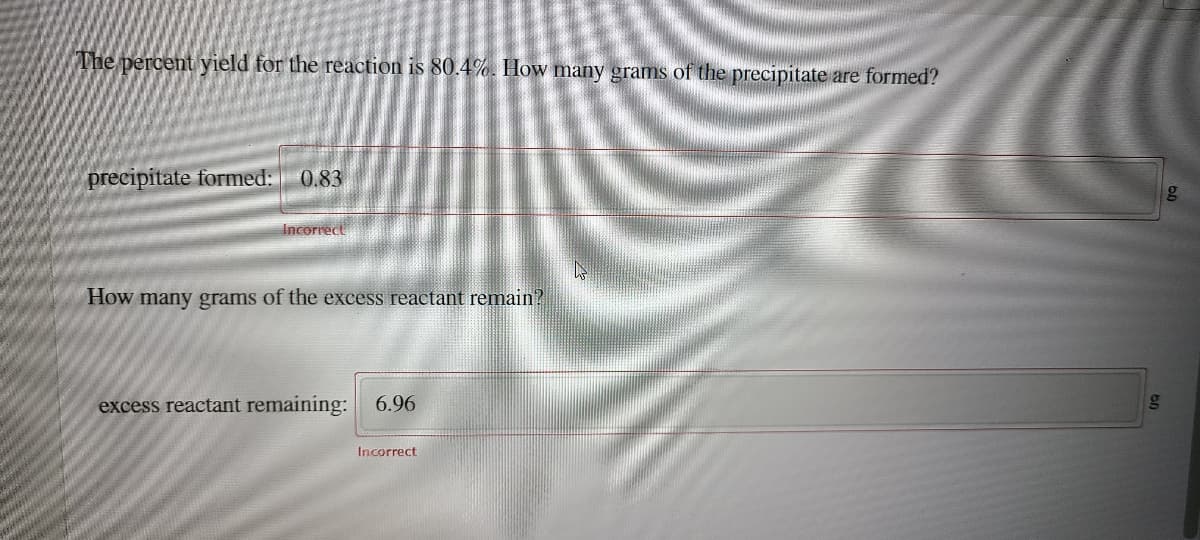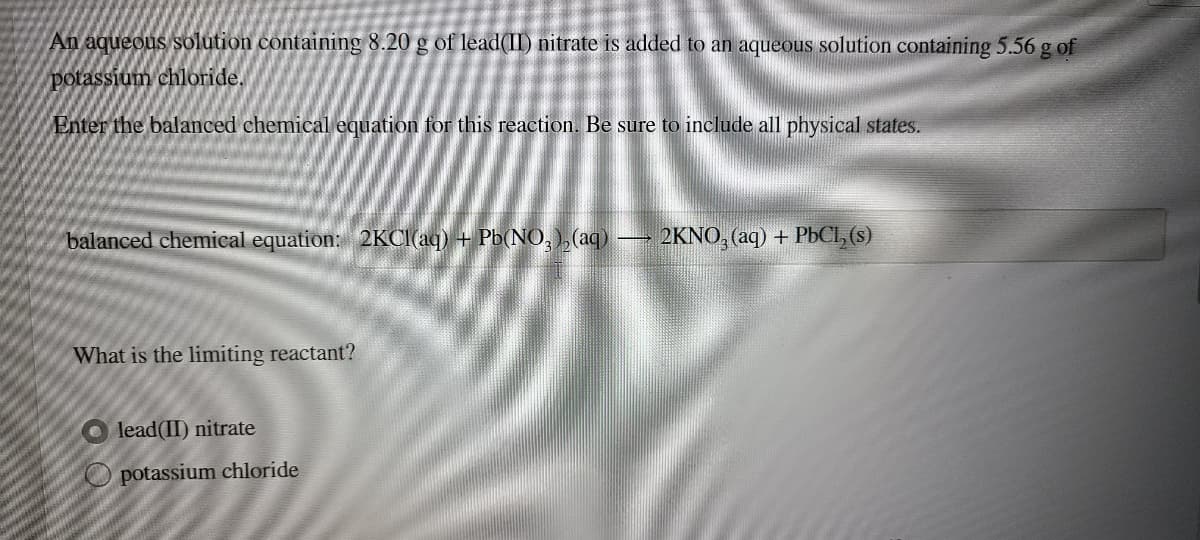The percent yield for the reaction is 80.4%. How many grams of the precipitate are formed? precipitate formed: 0.83 Incorrect How many grams of the excess reactant remain? excess reactant remaining: 6.96 Incorrect
The percent yield for the reaction is 80.4%. How many grams of the precipitate are formed? precipitate formed: 0.83 Incorrect How many grams of the excess reactant remain? excess reactant remaining: 6.96 Incorrect
Chemistry for Engineering Students
4th Edition
ISBN:9781337398909
Author:Lawrence S. Brown, Tom Holme
Publisher:Lawrence S. Brown, Tom Holme
Chapter4: Stoichiometry
Section: Chapter Questions
Problem 4.70PAE: 4.70 The particulate scale drawing shown depicts the products of a reaction between H2 and O2...
Related questions
Question
I can't seem to get the precipitate formed and the excess reacting remaining pls explain thanks

Transcribed Image Text:The percent yield for the reaction is 80.4%. How many grams of the precipitate are formed?
precipitate formed:
0.83
Incorrect
How many grams of the excess reactant remain?
excess reactant remaining:
6.96
Incorrect

Transcribed Image Text:An aqueous solution containing 8.20 g of lead(II) nitrate is added to an aqueous solution containing 5.56g of
potassium chloride.
Enter the balanced chemical equation for this reaction. Be sure to include all physical states.
balanced chemical equation: 2KCI(aq) + Pb(NO,),(aq) 2KNO, (aq) + PbCl, (s)
What is the limiting reactant?
lead(II) nitrate
potassium chloride
Expert Solution
This question has been solved!
Explore an expertly crafted, step-by-step solution for a thorough understanding of key concepts.
This is a popular solution!
Trending now
This is a popular solution!
Step by step
Solved in 2 steps with 1 images

Knowledge Booster
Learn more about
Need a deep-dive on the concept behind this application? Look no further. Learn more about this topic, chemistry and related others by exploring similar questions and additional content below.Recommended textbooks for you

Chemistry for Engineering Students
Chemistry
ISBN:
9781337398909
Author:
Lawrence S. Brown, Tom Holme
Publisher:
Cengage Learning

Chemistry & Chemical Reactivity
Chemistry
ISBN:
9781337399074
Author:
John C. Kotz, Paul M. Treichel, John Townsend, David Treichel
Publisher:
Cengage Learning

Chemistry & Chemical Reactivity
Chemistry
ISBN:
9781133949640
Author:
John C. Kotz, Paul M. Treichel, John Townsend, David Treichel
Publisher:
Cengage Learning

Chemistry for Engineering Students
Chemistry
ISBN:
9781337398909
Author:
Lawrence S. Brown, Tom Holme
Publisher:
Cengage Learning

Chemistry & Chemical Reactivity
Chemistry
ISBN:
9781337399074
Author:
John C. Kotz, Paul M. Treichel, John Townsend, David Treichel
Publisher:
Cengage Learning

Chemistry & Chemical Reactivity
Chemistry
ISBN:
9781133949640
Author:
John C. Kotz, Paul M. Treichel, John Townsend, David Treichel
Publisher:
Cengage Learning

Introductory Chemistry: A Foundation
Chemistry
ISBN:
9781285199030
Author:
Steven S. Zumdahl, Donald J. DeCoste
Publisher:
Cengage Learning

Chemistry: Principles and Practice
Chemistry
ISBN:
9780534420123
Author:
Daniel L. Reger, Scott R. Goode, David W. Ball, Edward Mercer
Publisher:
Cengage Learning

World of Chemistry, 3rd edition
Chemistry
ISBN:
9781133109655
Author:
Steven S. Zumdahl, Susan L. Zumdahl, Donald J. DeCoste
Publisher:
Brooks / Cole / Cengage Learning